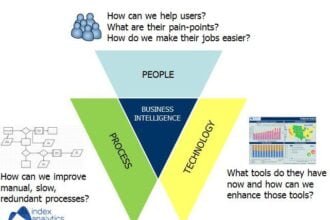

When I present on the topic of business intelligence failure, one theme that often comes up is inadequate user training. What’s fascinating to me is that everybody usually agrees, slightly wistfully, that there hasn’t been enough training done, often citing time pressures or budget constraints. But most seem to shrug their shoulders and say “that’s just how it is” – or, more fairly, have concluded there are more important problems to deal with.
I disagree. I think that the appropriate BI training is some of the lowest-hanging fruit around – I believe small improvements in training can have big effects in how much benefit organizations get from their BI technology investment. BI is not about technology, it’s about people. Information on its own is useless – it takes motivated, trained people to take the technology possibilities and turn them into actual business benefits.
This is true of all technology, of course, but BI is special among enterprise software because it’s still considered largely “optional” – that is, in most organizations, you won’t get fired for not actively using business intelligence software to its full potential. Most people, when they start a new role, are presented with a set of reports from their boss or their predecessor and told to look at certain figures on a regular basis. Few are motivated to go search beyond these figures, to think hard about what they could be doing to measure their effectiveness in more sophisticated ways.
If using business intelligence is too hard, or people don’t know how to do it, they won’t. This effect is sometimes called Mooers’ Law (not to be confused with Moore’s Law concerning integrated circuits), after Calvin Mooer, the computing pioneer who was first to coin the term “information retrieval” in 1950:
“An information retrieval system will tend not to be used whenever it is more painful and troublesome for a customer to have information than for him to not have it.”
We’re not primarily talking about training in how to use the BI products themselves, although ease-of-use is still important. Thanks to consumer internet technology and the advent of swipable mobile devices, nobody ever expects to have to read a software manual again. People now expect interfaces to be so intuitive that they can find their way around without any instructions – perhaps with the occasional hint when they have problems. The latest mobile products such as SAP BusinessObjects Mobile are starting to reach this level for “normal business people”, and SAP Visual Intelligence for “power” business users.
Interface training is still important if people request it, though – most computer-literate people woefully underestimate how hard it is for the “average person” to understand computer interfaces. Here’s an example of how extreme you can be in explaining things, courtesy of Marek Kowalkiewicz of SAP Research – an instruction sheet for how to plug in a standard LAN cable!

What’s more important than interface training is training in the business data used, and the analytic skills required to make sense of those numbers. Giving somebody a pencil does not make them Picasso! Other than former MBA students, few employees have any solid grounding in how to draw conclusions from data, or know enough about BI technology to be able to know what might be possible with the right training and tools.
Organizations make thousands of decisions every day. If every one of those decisions could be improved with just a little extra training, the cumulative benefits could be enormous.
So how should companies try to achieve this? First, they need to put training budget in a “lockbox”, protected from other project needs – and yes, these ultimately means “doing less” but “doing it better”. This in turn often means having to rethink KPIs and incentives, making sure that IT and business departments are given joint goals on the business success of BI projects, ratther than IT only being incented to deliver projects – i.e. install the software and create standard reports.
Note that your friendly software sales rep is unlikely to be your ally in this process. Software companies make higher margins on software than on services, so the sales compensation plans are structured to get the rep to spend as much of your budget on software as possible – even if that is not what’s ultimately best for the long-term success of the project or follow-on purchases (the odds are that the sales person will no longer be around at that point).
Second, it means doing real data-oriented training, ideally not in a classroom, but in the users’ own business environments, with the real data they need to make decisions – and doing it over time. People leave companies and change roles, and they need to be able to get up to speed quickly. The training you did when you first rolled out the BI solution last year is already inadequate. Thankfully, this is getting easier with collaborative learning solutions such as those from SuccessFactors that allow front-line employees to swap tips and learning and collaborative decision making in SAP Jam.
Share and Enjoy
• Facebook • Twitter • Delicious • LinkedIn • StumbleUpon • Add to favorites • Email • RSS






